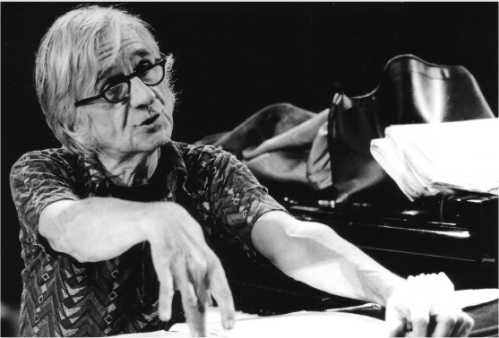 gil
evans
gil
evans gil
evans
gil
evans
"Gil Evans was born in Toronto, Canada in 1912.
Between 1941 and 1948, he worked as an arranger for the
sophisticated Claude Thornhill Orchestra -- settling at the end of that time in
New York City. After arriving in New York in 1946, Evans' modest basement
apartment behind a Chinese laundry soon became a meeting place for musicians
looking to develop new musical styles outside of the dominant bebop style of the
day -- though signature bebop artist Charlie Parker himself was among
those involved in these discussions and collaborations. With Miles Davis,
Gerry Mulligan, and others, Evans collaborated on a band book for
a nonet starting in 1948. The group had a booking for a week's appearance at the
"Royal Roost" as an intermission group on the bill with the Count
Basie Orchestra. Capitol Records recorded 12 titles by the nonet at three
sessions in 1949 and 1950, and these recordings were reissued on an LP as Miles Davis's
Birth of the Cool in 1957.
Later, while Davis was under contract to
Columbia Records, producer George Avakian suggested working with several
potential arrangers to the trumpeter. Davis immediately fixed on the option of
working with Evans again. The three main albums that resulted from this time
period are Miles Ahead (1957), Porgy and Bess (1958), and Sketches of Spain
(1960). Another collaboration from this period, Quiet Nights (1962) was issued
later, against the wishes of Davis, who broke with his then-producer Teo Macero
for a time as a result. Although these four records were marketed primarily
under Davis's name (and often credited as Miles Davis and the Gil Evans Big
Band), Evans' contribution was just as important. Their work coupled classic big
band jazz stylings and arrangements with the work of a skillful soloist. All
these collaborations feature Evans' big band arrangements, over which Davis
played with extraordinary melodic and stylistic skill. Evans also contributed
behind-the-scenes help to Davis' classic quintet albums of the 1960s.
From 1957 onwards Evans recorded under his own name too, releasing his impressionist albums Big Stuff (1957, aka Gil Evans & Ten), Out Of The Cool (1960), and The Individualism Of Gil Evans (1964). In 1965 he arranged the big band tracks on Kenny Burrell's Guitar Forms album. 1966 he recorded a 'special' Latin album with his orchestra, Look To The Rainbow, for the Brazilian singer Astrud Gilberto. In the 1970s, following Davis and many other jazz musicians, Evans worked in the free jazz and jazz-rock idioms, gaining a new generation of admirers. Evans had a particular interest in the work of rock guitarist Jimi Hendrix, and reportedly had a meeting scheduled with him to discuss building a big band around Hendrix before Hendrix's untimely death in 1970. Evans toured again after 1972, traveling twice to Japan, and touring extensively until 1987 for festivals and concerts in Europe.
In 1987, Evans recorded a live CD with Sting, featuring
big band arrangements of songs by and with The Police. He also played live with
Jaco Pastorius in Japan.
In 1981, Artists House released "Where Flamingo's Fly". The album was recorded in 1971 in New York City, and features Don Preston on synthesizers. The album got issued on CD by A&M in 1989.
| gil evans:
where flamingos fly (1981, cd, usa, artists house) - feat.don preston |